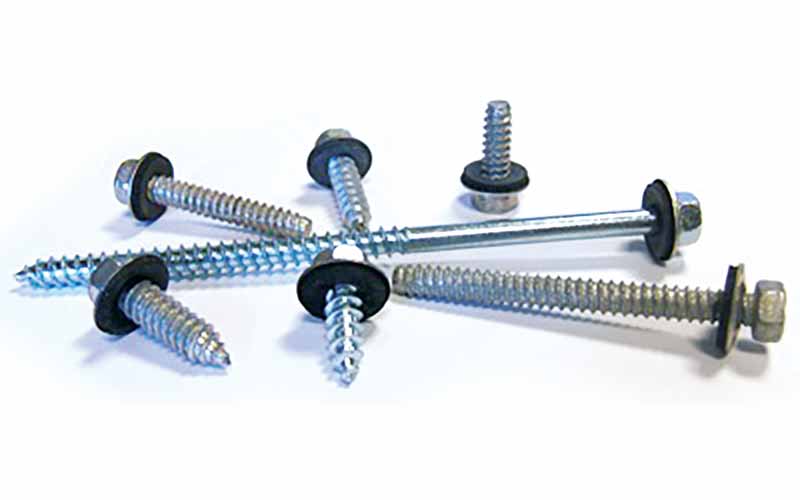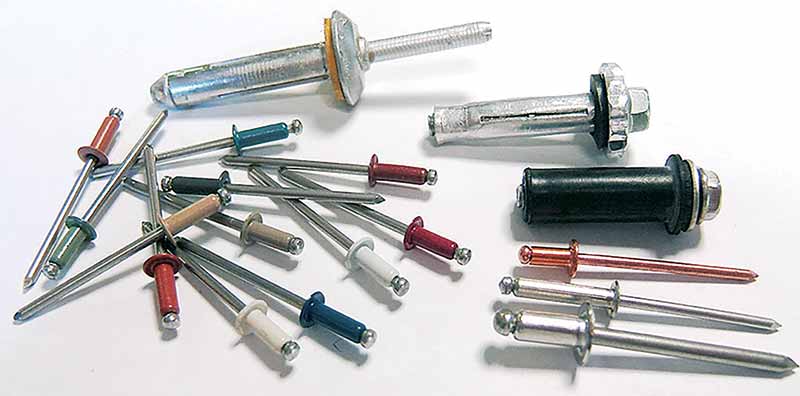Know your fasteners
by David Flaherty | 4 August 2024 2:07 pm
In metal construction, there are as many types of fasteners as there are options in the grocery store cereal aisle—and some of them even contain nuts too. Obviously, all fasteners are used for the same purpose. They connect members together and resist the forces that try to pull them apart. However, understanding the different types of fasteners used in metal construction is essential for selecting the right one for each application. Fasteners are made from various materials including steel, stainless steel, aluminum, zinc, and plastic, depending on the application requirements such as strength, corrosion resistance, or aesthetic consideration. Here are some of the countless types of fasteners that are used in metal construction.
Nuts and bolts
These traditional fasteners are often paired together. They are often used in structural connections where a great amount of strength is required. In many cases, they are used with washers to increase pull-through strength or to lock the connection in place. There are many types of bolt heads and nut styles beyond the traditional hex.
Self-tapping screws

This type of fastener is designed with a sharp, threaded tip allowing it to create its mating threads in materials such as thin metal or wood without needing a pre-drilled hole or a nut on the back side to secure the connection. There are many different types of self-tapping screws with different style heads.
Self-drilling screws
These fasteners have a drill-like tip, eliminating the need for pre-drilling holes. They are some of the most widely used fasteners in metal construction. These fasteners drill and tap the material in one operation.
Standing seam fasteners
These are used to attach standing seam roof panels. Usually, they are used in conjunction with a clip. Considered hidden fasteners, they can be self-drilling or self-tapping depending on the structure they are going into. Since they are concealed or hidden under the panel, they may need to be a low-profile fastener with a pancake or wafer head.
Exposed Fasteners
While hidden fasteners are concealed beneath the surface of the panels, exposed fasteners, which are still common in metal roofing systems, are exposed to the elements. They normally come with a sealing washer and something to resist corrosion. Corrosion-resistant fasteners (or long-life fasteners) may have a stainless steel or zinc-aluminum alloy cap. Additionally, these fasteners may have any of several different proprietary long-life coatings to ensure longevity to match the panels they attach.
Metal to wood screws
These types of fasteners are used in construction where metal panels are attached to wood framing. Mostly, they are self-drilling screws and are normally exposed fasteners.
Wood-to-metal fasteners
This fastener is designed to join wood components to steel structures or steel framing without the need for pre-drilling. They have a longer drill point with ears that bore the wood, allowing them to drill the steel without being slowed down by the wood. The ears break off as the screw threads begin to tap the steel. These usually have a flat head which countersinks so the head sits flush with the wood.
Stainless steel fasteners

Any fastener type you can think of probably comes in a stainless-steel version, with the exception being self-drilling screws. 304SS and 316SS cannot be hardened like carbon steel and, therefore cannot drill through anything but the thinnest steels. 410SS can be hardened to produce good drilling capacity but it lacks the corrosion protection of the 300 series stainless steels. Bi-metal fasteners have a mostly 304SS body with a hardened carbon steel drill point and the first three threads. This results in good drilling capacity, great corrosion resistance, and good ductility.
Blind rivets
Commonly referred to as pop rivets, these are used in areas requiring a flush surface where only one side of the material is accessible. A hole is drilled through the materials being joined, with a diameter slightly larger than the rivet body. A pin, called a mandrel, runs through the rivet body and extends out from the accessible side. A rivet gun (manual, pneumatic, or battery-operated) is used to pull the mandrel, expand the rivet body, and clamp the materials together tightly. Once the rivet is fully set, the mandrel breaks off and is discarded, leaving the rivet in place.
Structural rivets

These rivets are similar to blind rivets, but they are designed for high-strength applications where the joint needs to be both secure and durable. They are more proprietary, in nature often needing a specific tool for setting that is different than a pop rivet gun.
Expansion anchors
These types of fasteners expand once inserted into a pre-drilled hole. They are used in concrete, brick, and block to provide a secure hold for metal structures. There are several varieties of expansion anchors. Wedge anchors have a wedge-shaped end that expands when the nut is tightened, providing a stronghold in solid concrete. Sleeve anchors feature a sleeve that expands when the bolt is tightened, suitable for medium-duty applications. Drop-in anchors are installed flush with the surface of the concrete, requiring a setting tool to expand the anchor inside the hole. Lag shields are a type of expansion anchor designed to provide a stronghold by expanding as the lag screw is driven into them. Typically made from zinc alloy, they consist of a split cylindrical sleeve that expands upon the insertion of a lag screw. Split drive anchors have an expanding split when driven into a pre-drilled hole, providing a stronghold. They are also known as strike anchors, hammer-driven pin anchors, or nail-ins.
Concrete screw
Another way to fasten to concrete is with concrete screws. Concrete screws look like self-tapping screws. They require pre-drilling and have hardened, high-low threads which cut into the concrete. They come with hex, flat, or countersunk heads and are coated with corrosion-resistant finishes.
Powder-actuated fasteners
Also known as powder-actuated tools or shot tools, these are a type of fastening system that uses the energy from a small explosive charge to drive nails, studs, or other specialized fasteners directly into hard materials like concrete, steel, and masonry.
Gas-actuated fastening systems
These fasteners are also known as gas nailers. Similar to powder-actuated tools, they are used for driving nails, pins, or studs into hard materials. These tools are powered by a small, disposable gas cartridge under pressure, containing a liquefied gas mixture (such as propane and butane). The controlled explosive gas charge propels fasteners into the substrate with significant force. The tool includes a firing pin or striker mechanism, which ignites the gas charge when the trigger is pulled.
Anchor bolts
These are utilized to attach structures to concrete. Used in foundations, they come in different shapes such as L-shaped, J-shaped, or with a straight profile. These types of fasteners need to be set in place when the concrete is poured.
The construction industry uses a vast array of fasteners. Some types are familiar and commonly used. Some are designed for specific applications while others were designed to address unique challenges presented by different construction needs. By appreciating the nuances of each type and the engineering behind them, we are better equipped to make informed decisions that enhance the quality, performance, and efficiency of our construction projects.
Josh Krohn is the Engineering Service Manager at Triangle Fastener Corporation. He has 24 years of experience as an engineer and has headed up the TFC Tech Center in Cleveland since 2018.
Source URL: https://www.metalconstructionnews.com/articles/know-your-fasteners-2/